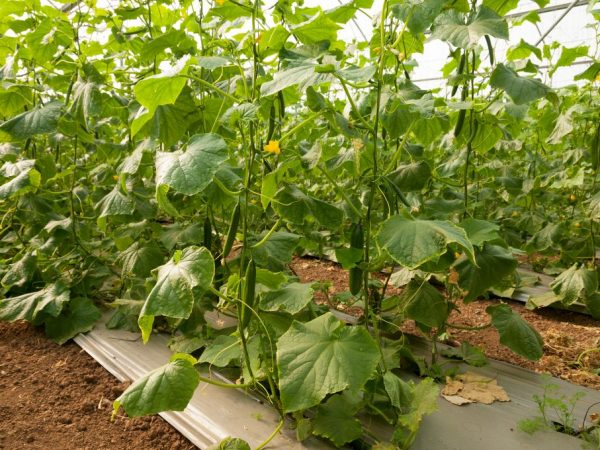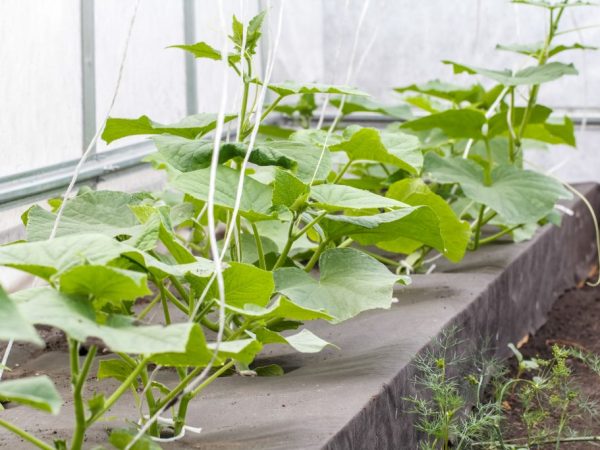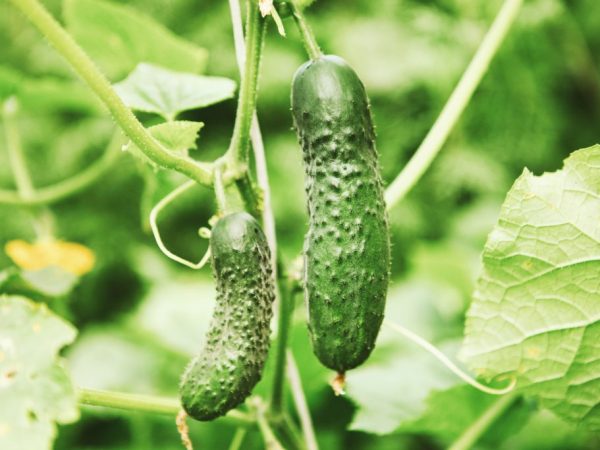Planting cucumbers under the film
Every gardener tries to get a plentiful early harvest of vegetables, but the climatic features of the region do not always allow this. To facilitate work and grow their favorite culture, farmers develop original methods. How is the planting of cucumbers under the film? Let's analyze the main points of the unusual agricultural method.

Planting cucumbers under the film
Method description
The fragrant vegetable is one of the most popular plants of domestic summer residents. However, the weather conditions are not always suitable for the normal development of culture, because India is considered the birthplace of cucumbers, with its abundance of sun and humidity. And a modern person does not have much time, so many of the care procedures are tiresome.
In the climate of the Middle Lane, you have to adapt to the requirements of the culture. Cucumbers prefer to be in the ground at a temperature not lower than 16 degrees. Growing in greenhouses is not always justified and is quite expensive for a simple summer resident. The use of the technology on polyethylene does not require significant financial investments, one sleeve of old agrofibre is enough.
In addition to heat and moisture, plants need to be constantly shaped and tied up. When planting cucumbers under the film, the weaving parts are located on the material and do not come into contact with the ground. The abundance of moisture from the soil at low temperatures is an excellent environment for the development of fungi, and in this way it is possible to protect the fruits and leaves from decay and facilitate care.
By the way, being on the warm surface of agrofibre, Zelentsi ripen two weeks earlier than their Soil counterparts. The crop is easily visible, so it is easy to harvest and control ripening. The seedlings do not need to be loosened and mulched, and the weeds in the technology fulfill their role. Cucumbers under the film are not a whim, but a way to protect plantings from possible troubles.
Plot
Preparation for growing a vegetable crop should begin in the fall. A well-lit place, not shaded by plants and outbuildings, is suitable. For the garden, leave a platform whose width is not less than 1.2 m.
The soil is carefully dug up, covered with plant residues. For this, you can take fresh compost, tree branches or shavings. The raw materials are folded on the site with a thick layer, added dropwise and formed a bed. In the process of decaying materials, heat and nutrients will be released.
When growing cucumbers on film, it is necessary to disinfect the earth from diseases. In the spring, the place is loosened and treated with a solution of copper sulfate. Sprinkle on top with any mineral fertilizer - nitrophos or ammophos. The soil should stand for at least three weeks, after which it can be planted.
How to plant
Planting cucumbers in open ground under a film has recently been gaining popularity among farmers in the Moscow region. Growing is suitable for summer residents who cannot constantly be near the plants. Holes are dug on the bed, 20 cm deep and at intervals - 35. A nutritious pillow is placed on the bottom of the holes:
- wood ash - 1 glass;
- superphosphate - 1 tablespoon;
- humus - half-liter jar;
- ammonium nitrate, potassium salt - 10 g each
Fertilizers are mixed with loose earth, the garden is thoroughly watered. It is necessary to plant six seeds in each hole, crush it with soil, and cover it with polyethylene. Planting cucumbers on film can be carried out with both transparent and black agrotechnical cloth. The edges are tightly fixed with bricks or boards.

Covering material will retain heat and moisture
The covering material will be constantly warm and humid. Plants are protected from temperature extremes and you don't have to worry that the leaves have burned out. Seedlings appear one week after sowing. With a sharp knife, cross-shaped cuts are made in polyethylene and the plants are “released” into fresh air. In each hole, four strong seedlings are left, and the rest are pinched. As the plants grow, they unravel along the film and completely cover it.
Care
When planting cucumbers on film, gardeners minimize their growing worries. However, it is impossible to just drop off and forget: every culture requires a little attention, so there are a few things to keep in mind. Subject to the recommended rules, the vegetable will delight you with a bountiful harvest.
Watering
Growing early cucumbers on film is a great option for busy gardeners. A moisture-loving plant is irrigated no more than once every 7-10 days. Even in hot seasons, a natural microclimate for the culture is created under cover, which will protect from heat and drought.
A hole is cut in the polyethylene near the wells, where plastic bottles of 1.5 liters without a bottom are inserted at a slight slope. It is easy to water and feed through the containers. The norm of water for each plant is from three to four liters.
For those who like to grow using drip technology, we recommend bringing a small tube to the liana, through which liquid is then fed. Remember not to spray with cold moisture. Agrarians collect water in tanks and heat them under the sun.
Fertilizer
Cucumbers on plastic wrap, like their counterparts in the open field, need additional feeding. It is better to carry out the procedure every time after irrigation: the roots will get drunk with moisture and will not suffer from the action of chemicals. There are five required deposit steps.
- When 4 sheets appeared. In a bucket of water, 25 g of potassium sulfate and superphosphate are diluted, two tablespoons of ammonium nitrate are added.
- Before flowering. 500 ml of mullein and 15 g of nitrophoska are poured into ten liters of liquid. We recommend enriching the solution with boric acid and manganese sulfate.
- Before fruit formation. After 14 days, the plants are fed with special preparations, which are indicated when tying cucumbers.
- Foliar. For vines growing over polyethylene, it will be possible to spray with nutrient solutions. Leaf treatments do not linger in the crop as nitrates.
By the way, according to some signs, you can determine the lack of a particular trace element. If the leaves of the lower row turn yellow, then most likely there is a nitrogen deficiency. With potassium starvation, the greens acquire a rich color, and the plates are covered with a yellowish border.
Soil treatment
If there is sowing of seeds or planting of seedlings under a covering material, then the usual agricultural activities are reduced as much as possible. Now you do not need hilling and you can forget about weeding. The fact is that weeds serve as "nannies" for cucumbers on film. Plants lift the polyethylene and create additional heat for the vegetable crop.
The only thing worth keeping an eye on is the condition of the land. With high humidity and increased decomposition of plant residues, fungi may appear. By the way, in order to avoid trouble, we recommend disinfecting the film with a solution in March:
- water - 1 bucket;
- formalin - 1 tablespoon;
- karbofos - 15 g.
As a preventive measure, young plants and the ground next to them can be watered with a liquid with ash and copper oxychloride. If the disease nevertheless struck any seedling, then it must be uprooted. The symptoms of the disease are drooping leaves.
Recommended varieties

You need to choose the right variety
Cucumbers on plastic wrap are best chosen from strong hybrids. With quality seed, it will be easy to grow plants from seed. Proven varieties should be planted in open ground and in a greenhouse.
Emerald
A strong self-pollinating variety of domestic selection is resistant to all diseases that can be provoked by planting under the film. Whichever method you choose (seedlings or seeds), the seedlings are always friendly. A powerful medium-branched bush has racemose ovaries, forms 5-6 zelents in a nodule.
With proper care, more than 4 kilograms of vegetables can be harvested from one plant. The fruits are cylindrical, covered with a skin with light tubercles. Pleasant aroma and absence of bitterness allows using it both fresh and canned.
Crane
If you want to grow on film, this is the best choice. The early bee-pollinated hybrid ripens within 6.5 weeks, and 10 kilograms of fruit will be collected from each square meter. Zelentsy is characterized by a pleasant crispy pulp, completely devoid of bitterness. It will be relevant in fresh slices and is suitable for making pickles, marinades.
It is better to plant a plant with seeds: seedlings have a strong immunity to powdery mildew, tobacco mosaic and peronosporosis. It will not be difficult to grow a culture, because all care under polyethylene will consist of watering. By the way, the hybrid has a long stem, so you have to carefully lay out the vine on the film.
Fontanelle
A strong medium-branched cucumber of domestic selection forms three ovaries in each nodule. The total yield from one square meter can reach 25 kg. A bee-pollinated plant begins to bear fruit 7 weeks after germination. It is recommended to plant a crop both in open ground and under a film.
Cylindrical greens grow up to twelve centimeters. The fragrant pulp without bitterness and without voids is suitable for universal use. The hybrid has good resistance to all "cucumber" diseases.
Krinitsa
The bee-pollinated plant will delight gardeners with a harvest in 45 days. A strong vine is recommended to be planted both under polyethylene and in open ground. A culture that is undemanding to care is not afraid of powdery mildew, excessive watering. It can be planted both from seedlings and seeds.
Gherkin-type fruits grow no more than 10 cm in length. The bright green skin with light stripes is covered with small tubercles. Zelentsy perfectly go for salting, and will also become a delicious addition to salad.
Competitor
The bee-pollinated plant will delight with the harvest 1.5 months after germination. Good survival of seeds and seedlings will make it easier to care for cucumbers under the film. Up to 4 kg of fruit can be removed from each vine. It is resistant to powdery mildew and is not afraid of excess moisture in the soil.
Zelentsy are covered with lumpy skin and grow up to 12 cm. Pleasant white flesh without voids and bitterness. The hybrid is intended for universal use, so it will be relevant in salads, pickles and marinades.
Growing cucumbers under plastic is an unusual way to get delicious vegetables in all climates. If planted and looked after correctly, then a bountiful harvest will be a gift for an attentive farmer. The recommendations present all the subtleties of the original technology.


